Bisexual pride flag

The bisexual pride flag was designed by Michael Page in 1998 in order to give the bisexual community its own symbol comparable to the Gay pride flag of the larger LGBT community. His aim was to increase the visibility of bisexuals, both among society as a whole and within the LGBT community.
The deep pink or rose stripe at the top of the flag represents the possibility of same gender attraction; the royal blue stripe at the bottom of the flag represents the possibility of opposite gender attraction and the stripes overlap in the central fifth of the flag to form a deep shade of lavender or purple, which represents the possibility of attraction anywhere along the entire gender spectrum.
The flag's aspect ratio is not fixed but 2:3 and 3:5 are often used, in common with many other flags.
© Symbols.com
